Award Books by Genre: Hugo Award

"A Feast for Crows", the fourth installment in George R.R. Martin's "A Song of Ice and Fire" book trilogy, takes up the challenge of transitioning the narrative from "A Storm of Swords". Readers were left off at the end of the War of the Five Kings, which had drawn havoc to all of Westeros. Throughout the course of this new story, attempts are made to unify the country, but as some relationships are mended- others are torn, and the tale of Westeros continues to grow ever more colorful with Martin's next installment.
The narrative focuses mainly on the happenings of central Westeros, with exclusions to Jon Snow and Daenerys Targaryen's plotlines (which are saved for the next novel.) Cersei Lannister's youngest son, Tommen Baratheon, now sits atop the Iron Throne, and takes guidance from his family members. Cersei and her children mourn the death of Joffrey and Tywin, whose demise is believed to be at the hands of the family Dwarf, Tyrion. However, even as Cersei attempts to make rational decisions, it becomes clear that her mind is clouded with vengeance.
In light of the fact that Martin killed off a number of main characters in his last novel, he pulls his readers into new storylines such as those with Brienne of Tarth as well as characters in Dorne and the Iron Islands. Arya Stark explores a new story arc in Bravos and all across the realm, religion emerges to have an even bigger impact on the plot. Overall, Martin does a fantastic job of bringing up new plot points and transitioning the trilogy into its next narrative.
I began reading this book immediately after the last, and while it’s true that it isn’t nearly as eventful as A Storm of Swords, the plot is equally as engaging. Players in the game of thrones continue to make political powerplays and hidden sabotages, all the while grounding their feet to climb the ladder of power.
One complaint I have with this novel is that its slow pace contrasts poorly with that of the last installment. Readers were left with suspense and eager anticipation for A Feast for Crows, and while they weren’t entirely disappointed, I felt that the beginnings of this book missed a few major fan expectations. This, in part, is due to the fact that there is a 5-year jump from A Storm of Swords to A Feast for Crows. Of course, some details are clearly left out over such a large gap.
If you decide not to continue with this series, I would recommend trying J.R.R. Tolkien’s “Lord of the Rings” trilogy, as it makes up for some of the imperfections with Martin’s work. With all that having been said though, I would certainly recommend continuing on to read this book. Its slow pace may at first deter you from reading, but, from my experience, if you stick through and finish the book, you will be glad to have done so. There are so many rich story-telling devices Martin imbeds into his writing, and paired with the fantastic plot of A Song of Ice and Fire, this book makes for a tremendous read!
Grade 10
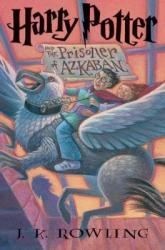
Very interesting way to add characters to the series and there is lots of adventure in this book. It really pulls on the heart-strings, and you go thru a rollercoaster of emotions. Way more in depth than the movie.
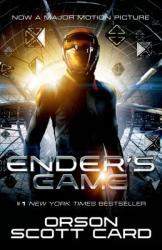
In another “lapse” of my reading habits, I didn’t manage to read
Ender’s Game until the movie of the same name came out in 2013. At the
time, all the sci-fi fans were eagerly anticipating a film that had taken
over 25 years to finally become a reality. While I thought the movie was
quite well done and engaging, after I read the book, I can understand why
some of the diehard fans of the series were disappointed. As is usually the
case with book-to-movie transitions, sub-plots often find themselves on the
cutting room floor. Of course, I don’t blame them for cutting what they
did; after all, it is called Ender’s Game.
Even though watching the movie first spoiled the exciting twist of the ending
when I read the book, I almost read the book differently knowing how it would
turn out. I could see the signs leading up to the shocking reveal, almost as
if I had read it before. I did appreciate the sub-plot with Ender’s
siblings and their efforts back on Earth as their brother was winning the war
in space. If anything, it helped to break up the intense action surrounding
the eponymous main character so that the reader could fully absorb what was
happening in the universe on a political level as well as a military one.
It is disappointing that there will likely be no more movies in this series
since the source material is full of interesting ideas that I’d like to see
on the big screen. Perhaps the series would be better suited for a television
show (a la Game of Thrones) to fully include all the different elements that
made it a classic of sci-fi back in 1985. Either way, I look forward to
exploring more of Orson Scott Card’s universe in the next book of the
series: Speaker for the Dead.
A fantastic sci-fi story with an incredible twist ending, I give Ender’s
Game 5.0 stars out of 5.
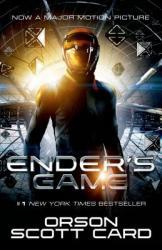
In another “lapse” of my reading habits, I didn’t manage to read Ender’s Game until the movie of the same name came out in 2013. At the time, all the sci-fi fans were eagerly anticipating a film that had taken over 25 years to finally become a reality. While I thought the movie was quite well done and engaging, after I read the book, I can understand why some of the diehard fans of the series were disappointed. As is usually the case with book-to-movie transitions, sub-plots often find themselves on the cutting room floor. Of course, I don’t blame them for cutting what they did; after all, it is called Ender’s Game.
Even though watching the movie first spoiled the exciting twist of the ending when I read the book, I almost read the book differently knowing how it would turn out. I could see the signs leading up to the shocking reveal, almost as if I had read it before. I did appreciate the sub-plot with Ender’s siblings and their efforts back on Earth as their brother was winning the war in space. If anything, it helped to break up the intense action surrounding the eponymous main character so that the reader could fully absorb what was happening in the universe on a political level as well as a military one.
It is disappointing that there will likely be no more movies in this series since the source material is full of interesting ideas that I’d like to see on the big screen. Perhaps the series would be better suited for a television show (a la Game of Thrones) to fully include all the different elements that made it a classic of sci-fi back in 1985. Either way, I look forward to exploring more of Orson Scott Card’s universe in the next book of the series: Speaker for the Dead.
A fantastic sci-fi story with an incredible twist ending, I give Ender’s Game 5.0 stars out of 5.
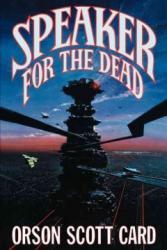
In this sequel to Ender’s Game, Orson Scott Card continues to provide a smartly-written plot that causes the reader to think about death in a whole new way. While the first book in the series gave some thought-provoking insights into war, simulation and the dangers of following orders, Speaker for the Dead examines cultural differences, religion, and the humanity of individuals who acted like monsters during their lives. Instead of moving on from the life of a deplorable person, Card manages to show the reader that a person’s life is made up of all its truths: the bad included with the good.
While Ender Wiggin seemed a little young in Ender’s Game, by Speaker for the Dead he’s aged into a wiser and much more complex character. His experiences in the first book helped to set him up as the universe’s devil and savior, a unique attribute set for a very cerebral character. I did appreciate how the physics of interstellar travel were used as limitations and constraints to make the situation of Ender’s age and experience much more believable. Of course, now that I’ve read the sequel to Ender’s Game, I’m not sure if the sub-plot with his siblings was nearly as important as I thought it would have been, thus making its omission from the movie a sensible choice.
What’s most intriguing about this science fiction adventure is how little science fiction is in it. Sure, there’s light-speed travel, alien creatures, and sentient computers, but when it comes down to it, the story is essentially a detective mystery solved by Ender Wiggin. Perhaps the sci-fi framework helped to create the ideal metaphor for understanding a culture different from our own, but these sci-fi elements could have easily been cut out, and a profound plot would have remained.
Another thought-provoking story in Ender Wiggin’s saga, I give Speaker for the Dead 4.5 stars out of 5.
For more reviews of books and movies like this, please visit
www.benjamin-m-weilert.com
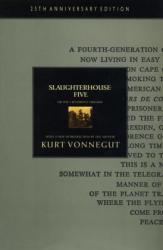
"So it goes..."
You may be thinking that based on the title it is the fifth book in a series of horror novels, but I assure you that it is not. Slaughterhouse-Five is a very thought provoking and poignant anti-war novel that has elements of science fiction, including 4th dimensional time travel and aliens. It’s a nonlinear story that follows a man named Billy Pilgrim as he travels throughout different moments in his life, weaving back and forth through differing time periods. He travels from his time as a chaplain’s assistant in World War II to his normal life with his wife and children to being an exhibit in an alien zoo on the planet Tralfamadore.
By becoming “unstuck in time”, as Billy puts it, he is able to relive these moments in his life and reflect upon them more deeply. This book is one of the best representations of 4th dimensional time travel that I've come across, and if you ever struggle to grasp the concept of time as the 4th dimension, as I do from time to time, then this book will certainly help create a better understanding of it. The book centers around Billy Pilgrim’s experiences during the war and all of the atrocities that he has seen, culminating at the end with the Bombing of Dresden, a moment which influences the rest of his life.
By being told out of chronological order, the structure of the book drives the importance and impact of the moment rather than just describing what happens next and it creates a sort of puzzle that the reader must put together. It is full of satire, wit, and black humor that is vintage Vonnegut and is one of the strangest meditations on war and humanity. If you want an extremely thoughtful book that challenges your perspective, then I highly recommend Slaughterhouse-Five by Kurt Vonnegut.
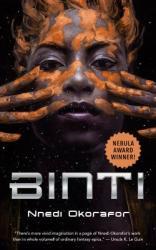
This was a fun little sci-fi novella. Binti is about a Himba girl from Earth -- the eponymous Binti -- who is accepted into a super-prestigious university and becomes the first Himba to go off-planet to attend college. There's a lot of prejudice against Himba by the Khoush on Earth, so Binti is nervous about traveling outside of her homeland, but when she gets on a shuttle with fellow students they find they have their love of science and astronomy in common, and she begins to feel optimistic about attending Oomza University. However, part-way into the journey the Meduse, a type of alien in a long war against the Khoush, attack the ship at dinnertime and kill all the students -- except for Binti. She’s not exactly sure why, but it seems to have something to do with a mysterious artifact she found in the desert that she keeps as a good-luck charm. Binti hides in her room, but she fears it will only be a matter of time until the Meduse kill her; she might not be Khoush, but she's a human on a Khoush ship, and that's enough. What seemed like the beginning of an exciting new life now is going to end just days after her departure.
I listened to Binti as an audiobook, and the narrator did a wonderful job with the story. I enjoyed Binti’s perspective and was drawn in by the back-story of their world -- the astrolabe technology everyone seems to use, Binti’s skill as a Harmonizer, living space-ships, and many other intriguing details. It’s extremely short -- just 90 pages -- and at the end I definitely wanted more information about the world and its people and technology. On the one hand, it’s good that Okorafor made me care enough to be interested in hearing more, but the tradeoff was that book felt a bit rushed/cramped at times. There are novellas that work perfectly in that form and are paced so well that they’re as rich and complete as a full-length novels, but this one didn’t quite meet those standards. This is intended to be the first book in a series, so I'm cutting it some slack for that reason, but it still didn't quite work on its own. The message was strong, but there were plot points I would have loved to see explored in more depth, relationships I wish had been better fleshed out, and some finer details of the setting that I wish Okorafor could have delved into to make for a more satisfactory ending. I still enjoyed the story for what it was, and I'll be looking out for the next entry in the series, but it fell a bit short of what I wanted. That being said, it's a creative story with a very cool setting, and I would certainly recommend Binti to fellow sci-fi fans.
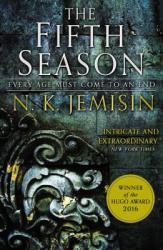
I loved this book. I've been looking for a new fantasy series for a long time now, but I haven't come across anything recently that's caught my eye. I almost gave up on The Fifth Season too, in part because the narration is in second person, which I found jarring at first, and in part because Jemisin drops you in the middle of the action with little explanation and no hand-holding. It took me a few chapters to get into the story and figure out what was going on, but I'm glad I stuck it out because the plot and characters ended up being great. Despite what I just said, I think it's almost better to go into this blind, but I'll try to describe it without giving too much away.
The continent our characters live on, "The Stillness," is a post-apocalyptic hellscape. There is near-constant seismic activity that triggers a new catastrophe (called a "Fifth Season") every few centuries -- sometimes in the form of massive crop-failures, sometimes in the form of volcanic eruptions, sometimes massive earthquakes that destroy whole regions (she includes a helpful appendix of these disasters if you're curious). In this world, there is a group of people known as orogenes (or more derogatorily as "roggas") who have some degree of control over seismic activity -- they can "sess" earthquakes, and, with training, prevent them from being too destructive. But they're also powerful, extremely dangerous, and widely despised -- many people kill their own children when they discover what they are, and it's often a race against time to see if a Guardian (their mysterious and sinister keepers) can arrive to collect the child before the family or the community has killed them. The plot isn't chronological; it moves around from chapter to chapter in order to tell three stories at three points in time: 20-odd years ago, when a young girl is taken to the capital to be trained as an orogene; some 10 years after that when a mid-level orogene goes off on a mission with her senior to investigate a disturbance in a coastal community; and "now," in the immediate aftermath of the latest apocalypse, when we follow a woman who is struggling to cope with her son's murder just as the quake hits.
I'm not going to say that it's an entirely original idea, but I think the execution was solid and I loved the dialogue and cast of characters. There's no lack of action, but Jemisin also takes the time to dig into her characters' emotional lives, and after a while the use of "you" starts to fade into the background. There's a strong focus on discrimination, both in terms of how orogenes are viewed in society and in terms of the treatment of subordinate nations and peoples by the Sanzed Empire that has conquered the continent. A lot of fantasy is set in pseudo-Europe (and often just pseudo-England), so it was refreshing to read something more diverse, and there's a wide variety of representation in terms of race, gender, and sexuality throughout. I would give this 4.5/5 stars if that were possible, but since it isn't I've left it at 4. It wasn't perfect, but it was a very strong start to the series, and I look forward to starting the second book, The Obelisk Gate, which just released this September. I would definitely recommend this to fans of fantasy.
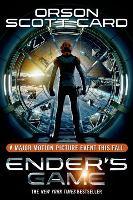
Set in a world where warfare is the top priority, all school systems are adapted to better shape children into viable subjects for the training program-Battle School. This program’s main goal is to shape perfect soldiers for the war against an alien race threatening humanity, or what’s left of it, as it is. While being the youngest student there by far, he advances far past the other students in warfare, academics, and strategy training very quickly. But, unknown to Ender, he is being used as a weapon in training and after to accomplish a goal that goes against all of his morals. I enjoyed this book because it was a new twist on an old idea-special treatment for the geniuses, but this time, it was not with their well-being in mind. From the cover to the synopsis, this book entices the reader to dive into this dystopian world. Besides the story, this book also has many thought-provoking moral lessons-do what’s right or serve the common good? This space centered tactic game is one the reader can play right along side Ender.
Reviewer Grade: 9
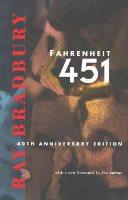
Fahrenheit 451 is a story about a future where people have become dull and lifeless. I liked the authors prediction of technology and how it takes over in the modern age. If you have to read it for school or if just for fun it shows the decent of peoples individuality when they are enamored by distraction all day long. Science fiction highly recommend.
Reviewer Grade: 11